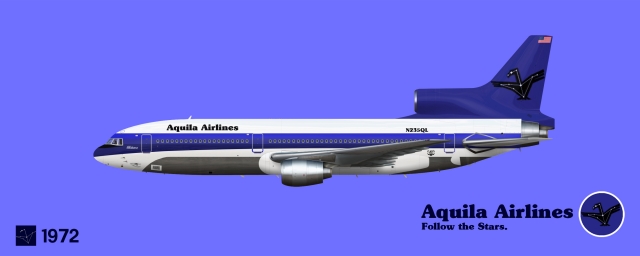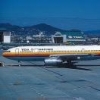Lockheed L-1011-500 Aquila Airlines
- Owner: Rigel (View all images and albums)
- Uploaded: Sep 12 2020 02:57 AM
- Taken: 2020:09:12 12:56:19
- Views: 1,229
- Album ZYX - Brands By Rigel
Template by Med. Logo and livery by Rigel

Approaching the end of the 1960s, the revolution in long-range air travel was coming. Two different types of airliners were competing to become the future of the aviation industry; Widebody airliners and Supersonic Transports (SSTs). Both of these plane types were making travelers and enthusiasts very excited, as both types were lightyears ahead of the first generation jetliners. New orders for both types started springing up, as the airlines prepared for the travel boom.
Aquila Airlines was one of these carriers. They were ecstatic about the future of air travel and the new opportunities they would provide in comfort and luxury. Despite this, they were slightly worried about the widebodies, or more specifically, the widebody airliner in development at the time, the Boeing 747. The plane was enormous, carrying 400+ passengers to almost any point they pleased, needing only one stopover. The size of the plane, however, was exactly what Aquila Airlines was iffy about. They weren't sure if the plane could be filled up on the routes it was designed to fly on, even their most popular routes to Asia and Europe. What Aquila Airlines wanted was a widebody plane that carried slightly less passengers than the 747, around 250 passengers, but with similar range and cabin outfit opportunities.
The two main contenders in this new tender were McDonnell Douglas and Lockheed. McDonnell Douglas decided to use a lot of technologies from the DC-8 and DC-9 airliners for their new widebody, so that the plane would be cheap, efficient, it could get to the market quick, and there would be a reduced risk of delays and technical problems. On the other hand, Lockheed, who had never made a fanjet airliner before, decided to go all out, putting all of the new technologies available in the industry into their new product, named the L-1011. The plane had some of the most advanced autopilots in the world, and a revolutionary autoland system, allowing the L-1011 to land by itself, in zero visibility weather, without any inputs from the pilots, while other planes had to circle the airport waiting for the fog to lift, or divert to another airport.
Aquila Airlines was very excited about the L-1011, having always been a big Lockheed fan since they got their first Vega in 1928. When news of the L-1011's extraordinary features were unveiled to them in 1966, they got even more excited. The only problem surrounding the plane was that it was only available with foreign engines, but the airline didn't mind. The RB-211 looked very promising, and if it meant they could get this incredible plane, then they would. In May 1966, Aquila Airlines made up their mind. On June 2nd, 1966, Aquila Airlines placed an order for 22 Lockheed L-1011 TriStars, becoming the launch customer for the aircraft. With the new order, the L-1011 program was officially launched, and production started.
Aquila Airlines was planning to get their first L-1011 by mid-to-late 1971, but delays of the aircraft were huge, mainly due to the problems with the Rolls Royce powerplants. The airline was getting impatient with the delays, and threatened to switch over to the DC-10, which by that tie was already in service. With the L-1011 delayed and the 747s still on their way, Aquila Airlines had no widebody airliners in their fleet, putting them seriously behind competitors who had bought the DC-10. But then the L-1011 entered service on 24th April 1972.
The plane immediately became a favourite among passengers and pilots alike. The cabin width was slightly more than that of the DC-10, allowing for slightly wider seats, which increased passenger comfort. The autoland system allowed the plane to continue operating in dense fog, while the 747s and DC-10s around it sat idle at airports. This allowed for increased on-time performance, making customers happier. And the RB-211s were proving to be very reliable and efficient, much more so than the CF-6s on the DC-10. Aquila Airlines were extremely happy with the L-1011, and more and more were being ordered and delivered, replacing the DC-8s and 707s on transcontinental and transatlantic routes. The plane's cabin was outfitted in much the same way as the 747, with economy, business and first classes all directly taken from the Jumbo. Aquila Airlines was also one of only a few customers to have the lounge on the lower deck. This feature was available on a select few L-1011s.
Then, in 1978, the L-1011-500 model came along. This model had a shortened fuselage, reducing the mass, an extended wing and beefed-up engines. All these improvements and more allowed for a longer range of 9,600km. The L-1011 was now a true long-haul aircraft. Aquila Airlines was very excited about the L-1011-500 program, and placed an order for another 15, replacing some of the older L-1011s on longer-range flights. Now, flights to Tokyo and other places in Asia, could be carried out, via San Francisco, due to the L-1011-500 not being able to make the distance with the capacity the airline wanted to have.
Shown above is N235QL, the airline's fifth L-1011-500, wearing the 1972 livery introduced on this aircraft. The L-1011 fleet would operate until 2004, until they were retired and replaced by the Boeing 767 and Airbus A330. N235QL is named "Bellatrix", the third-brightest star in the Orion constellation.
Updated logo. 747 will be updated soon.
Leave feedback! Any and all feedback helps (but preferably constructive).
You're off to a decent start, however, a few things can be fixed to make this better. The design is nice, but it could benefit from a better choice of blue rather than the neon blues you've chosen. The logo could be improved, its a bit clip-artish for 1972. Overall you're getting there, just take more time and research and your end result should be better.
Thank you for the criticism! The blues will be changed, I might make them the shades that are on the modern livery. The logo is a different problem; I wanted something space-related, and it just so happened that Aquila is the Latin word for eagle, so I chose this name. However, this made the logo choice and ability to modify it very difficult. I do see how it looks a bit clipart-ish, and I might end up scrapping the logo entirely and coming up with a new one.
Yeah everything is good but the logo
Yeah everything is good but the logo
Thank you! Yeah the logo will be changed. Only problem is, I haven't the foggiest clue as to what to use. I want to use stars, and I want to use an eagle, as the name is a constellation, and it is also Latin for "eagle", but I have no idea how to implement them in a way that doesn't look clipart-y or just bad...

 Sign In
Sign In Create Account
Create Account














You're off to a decent start, however, a few things can be fixed to make this better. The design is nice, but it could benefit from a better choice of blue rather than the neon blues you've chosen. The logo could be improved, its a bit clip-artish for 1972. Overall you're getting there, just take more time and research and your end result should be better.